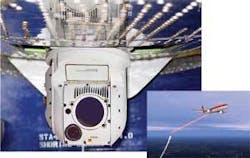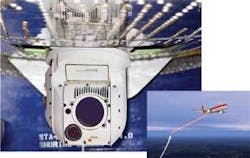BAE Systems applies military technology to commercial airliner defense system
By Courtney E. Howard
MANCHESTER, N.H. - BAE Systems’s JetEye infrared missile-beating countermeasure system, which takes advantage of military-derived technologies, has entered the third phase of the U.S. Department of Homeland Security (DHS) counter-man-portable air defense systems (C-MANPADS) program.
C-MANPADS is designed to protect commercial airliners from infrared-guided missile threats via an on-board countermeasures system. The BAE Systems innovation, JetEye, is based on the U.S. Army’s Advanced Threat Infrared Countermeasures system that was designed to protect military aircraft from missile threats.
“DHS is leveraging the investment by the Department of Defense (DOD) to protect commercial aircraft,” explains Stephen duMont, BAE Systems’s business development director for the C-MANPADS program in Nashua, N.H.
JetEye, based on the latest missile-fighting technology on military aircraft in war zones, is a laser-based infrared countermeasures system designed to confuse and divert infrared-guided missiles for use against military and civilian aircraft. More than 500,000 shoulder-fired missiles are thought to be in circulation worldwide.
“We took technology that protects the lives of our service men and women every day and integrated it in a system that has proven its effectiveness on a commercial platform,” says Burt Keirstead, BAE Systems program director for JetEye.
The system’s UV detectors look for a specific energy that is characteristic of missile launch. Its common missile warfare systems (CMWS) sensors communicate with onboard processing electronics, which triggers a series of flares as a decoy to steer the threat away from the commercial aircraft. Because missiles are looking for an infrared signature, JetEye uses a multiband laser to send light energy into the front end of the missile to blind it and steer it away from airliners.
DHS selected BAE Systems in 2004 to adapt proven military technology to protect commercial aircraft against shoulder-fired missiles. The company partnered with American Airlines Maintenance and Engineering, a division that provided not only the test aircraft, a Boeing 767, but also engineering services to assist in the refinement of the anti-missile solution for commercial airliners.
“The American Airlines maintenance and engineering team were integral in helping us understand how best to adapt this technology for seamless integration into the commercial airline industry,” Keirstead says.
The JetEye system was first flown on a commercial airliner and tested against simulated man-portable air defense systems on the American Airlines Boeing 767 in November 2005 at Fort Worth Alliance Airport in Texas. BAE Systems’s JetEye recently completed Phase II, during which the solution was proven to be effective.
Now in Phase III, which will span 18 months, JetEye will continue flying on the same American Airlines Boeing 767, as well as on an ABX Air cargo aircraft. Also during that time, BAE Systems will focus on the reduction of costs to the airline industry, which currently is facing financial challenges. Among the potential remedies to be investigated by BAE Systems engineers are streamlining system installation, reducing aerodynamic drag, and improving reliability and maintainability.
BAE Systems hosted more than 200 employees, guests, members of the N.H. Congressional delegation, and supporters at an event celebrating JetEye and the company personnel behind the system. Attendees of the celebration and technology briefing, which was Sept. 11 at the Manchester-Boston Regional Airport, not far from the company’s N.H. facilities, toured the aircraft to view elements of BAE Systems’ JetEye solution.
BAE Systems also holds a contract to outfit U.S. Army aircraft, including helicopters, with its directed-infrared countermeasure system. To date, BAE Systems has delivered more than 14,000 infrared countermeasure systems worldwide.

